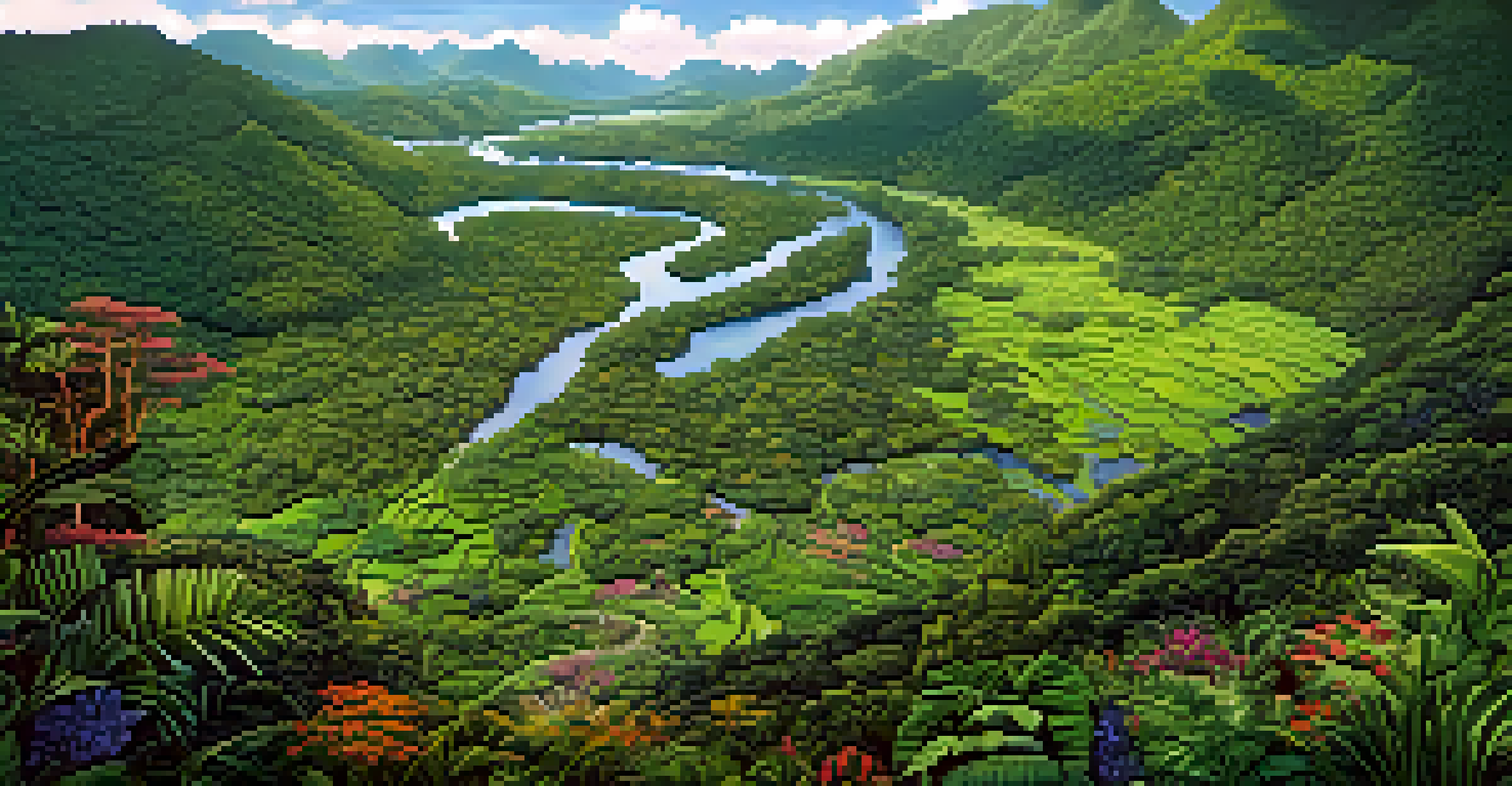Exploring the Atlantic Forest: Wildlife and Conservation

Introduction to the Atlantic Forest and Its Importance
The Atlantic Forest, known as 'Mata Atlântica' in Portuguese, is a biodiverse ecosystem located along the eastern coast of South America. Stretching from Brazil to Paraguay and Argentina, this unique forest is home to thousands of plant and animal species, many of which are found nowhere else on Earth. Its lush landscapes provide vital resources for local communities and contribute to the planet's overall health.
The greatest threat to our planet is the belief that someone else will save it.
Historically, the Atlantic Forest covered about 1.3 million square kilometers, but due to deforestation and urbanization, only about 12% remains today. This drastic loss has not only endangered countless species but also disrupted the ecological balance of the region. Understanding the significance of this forest is crucial for both conservation efforts and the well-being of the communities that rely on its resources.
The Atlantic Forest is often compared to the Amazon rainforest, but it has its own distinct characteristics and challenges. While the Amazon is predominantly a tropical rainforest, the Atlantic Forest includes a range of ecosystems, from tropical to subtropical regions. This diversity makes it a hotspot for wildlife, but it also means that conservation efforts must be tailored to various habitats within the forest.
Diverse Wildlife: Unique Species of the Atlantic Forest
The Atlantic Forest boasts an incredible array of wildlife, including some of the most unique and endangered species in the world. Home to the golden lion tamarin, a small monkey with a vibrant mane, this forest is a treasure trove of biodiversity. Other notable inhabitants include the jaguar, various species of birds, and countless insects, all playing crucial roles in the ecosystem.

Among the forest's inhabitants, many species are endemic, meaning they are found only in this specific region. For example, the Brazilian three-toed sloth and the Atlantic forest snake are just a couple of the fascinating creatures that call this habitat home. This unique wildlife not only adds to the beauty of the forest but also serves as a reminder of the importance of preserving these delicate ecosystems.
Atlantic Forest's Biodiversity Crisis
The Atlantic Forest has lost 88% of its original area, endangering countless unique species and disrupting ecological balance.
However, the survival of these species is under threat due to habitat destruction, illegal wildlife trade, and climate change. Conservation initiatives are essential to protect these animals and their habitats, ensuring that future generations can appreciate the rich biodiversity of the Atlantic Forest.
The Role of Indigenous Communities in Conservation
Indigenous communities have lived in harmony with the Atlantic Forest for centuries, understanding its ecosystems and resources. Their traditional knowledge and sustainable practices play a vital role in conservation efforts. By integrating indigenous perspectives, conservationists can develop more effective strategies for protecting the forest's biodiversity.
In the end, we will conserve only what we love; we will love only what we understand; we will understand only what we are taught.
These communities often rely on the forest for their livelihoods, using its resources in a way that respects the environment. Engaging indigenous peoples in conservation not only helps preserve their culture but also fosters a sense of stewardship for the land. Their deep-rooted connection to the forest can guide restoration projects and promote biodiversity.
Moreover, by supporting indigenous rights and land management, we can foster a collaborative approach to conservation. This partnership can lead to innovative solutions that benefit both the local population and the ecosystem, ensuring a sustainable future for the Atlantic Forest.
Conservation Challenges Facing the Atlantic Forest
Despite various conservation efforts, the Atlantic Forest continues to face significant challenges. Deforestation, primarily driven by agriculture, urbanization, and logging, has drastically reduced its size and fragmented habitats. This fragmentation not only threatens species survival but also disrupts ecological processes essential for maintaining biodiversity.
In addition to habitat loss, climate change poses a severe risk to the forest's ecosystems. Rising temperatures and altered rainfall patterns can affect species distribution and health, further exacerbating the challenges faced by this unique environment. As the threat of climate change grows, immediate action is necessary to mitigate its impacts.
Indigenous Role in Conservation
Indigenous communities play a crucial role in conservation through their traditional knowledge and sustainable practices.
Efforts to combat these issues must be multi-faceted, involving local communities, governments, and international organizations. By raising awareness and promoting responsible land-use practices, we can work together to protect and restore the Atlantic Forest for future generations.
Successful Conservation Initiatives in the Region
There have been several successful conservation initiatives aimed at preserving the Atlantic Forest. One notable project is the Atlantic Forest Restoration Pact, which seeks to restore 15 million hectares of forest by 2050. This ambitious plan brings together government agencies, NGOs, and private landowners to collaborate on reforestation and sustainable land-use practices.
Another example is the creation of protected areas, such as national parks and reserves, which help safeguard critical habitats for endangered species. These protected areas not only provide refuge for wildlife but also promote ecotourism, creating economic opportunities for local communities. By showcasing the importance of the forest, these initiatives encourage greater public awareness and support for conservation.
These efforts highlight the power of collaboration in conservation. By working together, stakeholders can share resources, knowledge, and best practices, leading to more effective strategies for preserving the Atlantic Forest.
The Importance of Ecotourism in Conservation
Ecotourism is a powerful tool for promoting conservation in the Atlantic Forest. By attracting visitors to experience its rich biodiversity, ecotourism generates revenue that can be reinvested in conservation efforts. This creates a financial incentive for local communities to protect their natural environment instead of exploiting it.
Moreover, ecotourism fosters a deeper appreciation for the forest's ecosystems among visitors. When people witness the beauty of the Atlantic Forest firsthand, they are more likely to support conservation initiatives and advocate for sustainable practices. This increased awareness can lead to a broader cultural shift towards valuing and preserving the environment.
Ecotourism as a Conservation Tool
Ecotourism generates revenue for conservation efforts while fostering appreciation for the Atlantic Forest's rich biodiversity.
However, it's essential to approach ecotourism responsibly to minimize its impact on the ecosystem. Sustainable practices, such as limiting visitor numbers and promoting low-impact activities, ensure that ecotourism benefits both the environment and the local communities. By striking this balance, we can enjoy the wonders of the Atlantic Forest while protecting it for future generations.
How You Can Contribute to Atlantic Forest Conservation
Everyone can play a role in the conservation of the Atlantic Forest, even from afar. One of the simplest ways to contribute is to support organizations dedicated to protecting this unique ecosystem. Whether through donations or volunteering, your efforts can help fund crucial conservation projects and raise awareness about the challenges facing the forest.
Additionally, consider making eco-friendly choices in your daily life. Reducing waste, opting for sustainable products, and supporting businesses that prioritize environmental responsibility can collectively make a significant impact. Every small action contributes to a larger movement toward protecting our planet's precious resources.

Finally, spreading the word about the importance of the Atlantic Forest can inspire others to take action. Share information on social media, educate your friends and family, or even participate in local conservation events. By fostering a sense of community and shared responsibility, we can work together to ensure the survival of this vital ecosystem.